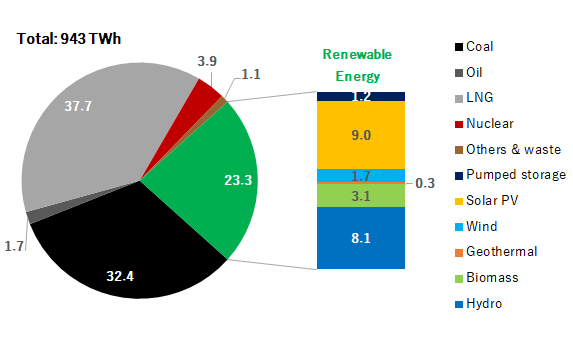According to preliminary statistics from the Japanese Ministry of Economy, Trade and Industry – not including private power generation, the share of renewable energy in the country’s electricity generation mix reached 23% in fiscal year 2020. This encouraging success is a good reason for Japan to become more progressive.
Not including private power generation for which no data is available yet, the share of renewable energy reached 23% in Japan in fiscal year (FY) 2020. This is right in the middle of the country’s renewable energy FY 2030 target of 22-24%. Later on, when it will be possible to include private power generation data, the share of renewable energy will probably slightly decrease because most of private power generation is based on fossil fuels. Even so, this 23% share is a remarkable achievement showing that Japan can use the new opportunities as fast as other countries in the world. That should call for more ambitious renewable energy goals and more forward-thinking approaches as policymakers now consider how to pave the country’s way towards carbon neutrality.

Source: Ministry of Economy, Trade and Industry, Power Survey Statistics (downloaded June 30, 2021) (in Japanese).
At the heart of a carbon neutral Japan should be low cost, low carbon electricity. Since the accident at the Fukushima Daiichi nuclear power plant, renewable energy has demonstrated that it can be successfully and rapidly expanded – especially solar photovoltaic. As a matter of fact, renewable energy positive developments are exceeding the Government’s targeted speed. This is even more impressive that renewable energy in Japan still faces some unique unnecessary regulatory challenges (e.g., curtailment rule…).
In comparison, in the same period of time, nuclear power dearly struggled because of safety and cost issues. Its share in the country’s total electricity generation decreased to below 4% in FY 2020, which is nowhere near renewable energy’s contribution. Moreover, there is little doubt that nuclear will significantly fail to meet its target of 20-22% in FY 2030.
It is clear that renewable energy has won the competition of low carbon technologies.
It is thus a priority for Japan to embrace low carbon electricity from renewable energy more ambitiously and to take a more proactive stance towards their integration into energy systems. There is no objective reason to limit the share of renewable to 50-60% in electricity generation in 2050 as currently discussed by the Government. Renewable energy integration solutions are certainly not lacking (i.e., flexibility both on the supply and demand sides, energy storage, network reinforcement and expansion…). The real challenge is, however, to identify the best mix of solutions in the country’s specific context. It is not an easy task, but starting with the right innovative mindset will greatly facilitate it.






